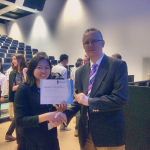Report from the Infrastructure Investment in Emerging Markets and Developing Economies Conference
Oxford University, 2 July, 2015
Graham Thrower, Doctoral Researcher, iBUILD and CURDS/ GPS, Newcastle University
This one day conference, jointly hosted by Oxford University’s Smith School of Enterprise and the Environment, Infrastructure Transition Research Consortium, and the Environmental Change Institute, sought to address the ongoing issue of how to close the infrastructure gap in Emerging Markets and Developing Economies (EMDEs).
Setting the scene it cited the World Bank’s estimate that US$1-1.5 trillion pa will be needed through 2020 to meet identified infrastructure demand from industry and households. Governments remain financially constrained and attracting private financing is therefore regarded as vital. An aggravating factor in EMDEs has been a lack of bankable projects (though as we shall see not a lack of aspiration) and an uneven enabling environment for private investment. Whilst recent initiatives like the BRICS initiated New Development Bank (NDB) and the Asian Infrastructure Investment Bank (AIIB) represent further institutional impetus to address these issues, it is clear that merely increasing funds available for infrastructure development is, on its own, not the answer. Infrastructure assets, as iBUILD has always argued, do not exist in isolation. They are inter-dependent and require a ‘systems-thinking’ approach that does not always sit easily with conventional project financing methodologies. They also, as Hisaka Kamura of the Asian Development Bank (ADB) noted, have cross-border impacts and considerations that recent initiatives like the Silk Road Fund is designed to encompass. Despite this however, a holistic systems approach still poses a challenge to governments, development agencies, MDBs and institutional capital alike.
The demand issue
Bernard Sheehan of the IFC presented an illuminating analysis of current and projected installed power capacity across a number of EMDEs out to 2020. Whereas similar plans a decade ago would have typically shown forecast 5% to 10% increases in capacity; now Ghana, Ivory Coast and Kenya are forecasting a tripling by 2020; Ethiopia and Nigeria a quadrupling; and South Africa a twenty-fold increase. This implied investment equates to 10x the annual total Public Private Investment in African Energy in 2000-2010. In India the increase is 50 fold, China expects to more than double. The investment implications of these plans represent in absolute terms, sums that are simply beyond any ability by the global public and private markets to provide. We should also remember that installed power capacity is not an isolated asset, but perhaps one of the best indicators of an underlying volume of industrial and domestic demand, and therefore implies the construction of a larger underlying installed infrastructure base.
It was at this point that I wondered what was driving these stated targets, and the current universal exhortations to ever greater infrastructure growth. Are we seeing the congruence of (a) a desire by the West to export a model of fiscal conduct, governance, contract and procurement law (Bourdieu’s soft power) via a hegemonic use of PPPs, (b) surplus global institutional capital seeking yield in ever more esoteric markets (as suggested by Marx and Braudel), or (c) the unmediated, endogenous infrastructure needs of nation states. Addressing this latter driver, I think it is clear that there is a genuine underlying need to improve the capacity and quality of installed infrastructure due to factors of population growth, climate change, sustainability and urbanization. Infrastructure however is increasingly seen as a proxy for wider economic development and competitiveness; and the advertisement of ambitious growth plans in this area, as a sign that a country wishes to be part of the developed country club. In a market that is full of investment noise, EMDEs need to ensure their plans are heard. How better to gain investor attention than to ensure these plans are on a grand scale?
The Global institutional picture
The AIIB have set out their stall to be a responsive, fast and easy partner to deal with. With surprising candour, the AIIB stated that they would leave non-financial targets (such as requirements to alleviate poverty, make environmental remediations etc..) to other MDBs/MFIs. The AIIB’s preference for pragmatism over dogma was summed up by their statement: ‘if its bankable, we’ll do that’. Their list of eligible projects was also wider than most MDB peers: brownfield as well as greenfield; and all the usual sectors plus coal. Professor Gordon Clark noted the challenge of keeping the AIIB’s global shareholders and co-investors on board with its goals of environmental and societal sustainability whilst at the same time investing in brownfield coal.
A number of other contributors noted the existence of relative bargaining power as an issue for EMDE borrowers. A recent working paper for the Intergovernmental Group of Twenty Four and the Global Green Growth Institute (Humphreys, 2015) addresses the diminished voice of the EMDE borrower within the MDB approval process. This has led to borrowers pursuing more expensive financing options without societal and environmental safeguards, due to a wish to avoid lengthy, complex, uncertain and distant approval processes within international multilateral institutions. Examples of Latin American borrowers spurning the IDB for China EximBank were cited in these discussions. It has been seen to that the emergence of PPP as the hegemonic financing solution of international institutional capital, similarly disempowers the EMDE borrower.
Towards a locally specific solution
There was discussion of the local in two contexts. Firstly, methodologies for making smaller scale local assets suitable for attracting non state investment. Secondly, it considered local sources of funding either as sole funders or in partnership with global MDB or private institutional capital.
The IDB and ADB see the need to create dynamic sector (or sub-sector) clusters to achieve scale and minimise transaction costs. These are particularly necessary in areas of small population, low per capita income, remoteness from investors, and where there is a lack of domestic supporting industries. A case study discussed was recent private sector participation in China; for tap water treatment, wastewater treatment, and locally specific dam projects. The ADB took a portfolio approach for these small rural wastewater projects, since they were too small to do on a stand-alone basis. Aggregation allowed the ADB to become involved as an enabling partner but critically they kept multiple local project vehicles in the overall structure. These small projects within the overall framework were then co-invested by local finance institutions and banks.
The development of endogenous financing solutions is now typically focused around local currency bond markets and increased pension fund allocations for infrastructure. A significant issue remains the often high domestic interest rates within EMDEs, the fact that local lenders are unused to long tenor and to financing construction risk, and the lack of funding and deal liquidity within nation state jurisdictions; all of these issues currently being examined by the G20.
Where there are significant sources of domestic capital in EMDEs such as Namibia, Sri Lanka, Malaysia, and Singapore they remain largely invested in government bonds rather than infrastructure. As the World Bank noted, this can only change when MDBs, institutional capital and national governments seek to jointly develop regulatory frameworks, understanding of infrastructure as an asset class, pension fund reform, and a clear prioritization of well prepared projects oriented to local needs. These measures need to move in lock-step, and successful examples such as Chile’s endogenous pension funds’ involvement in the national road building program were cited as worthy of replication.
It is in these areas that today’s MDBs and international development organisations have a critical role in developing and sharing best practice. Certainly there was a strong feeling that a robust and transparent MDB and international community has a role to play to ensure locally appropriate solutions are not subsumed in the deployment of global private institutional capital as countries rush to upscale their infrastructure.

 Miss Napaporn Tangtinthai receiving the 1st place winner award presented by Chris Kennedy
Miss Napaporn Tangtinthai receiving the 1st place winner award presented by Chris Kennedy